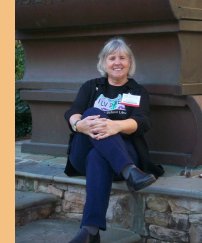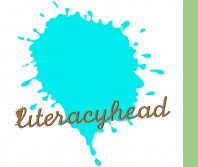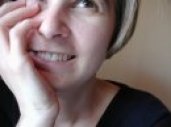|
Once upon a time, teachers chose their profession because they were excited to use their skills and creativity to educate students. Unfortunately, many educators today feel that standards-based instruction has leached creativity out of the classroom.
The result? Frustrated teachers who don't have time to teach and students who are being drilled in the art of test taking.
In this issue we provide some resources for keeping creativity in the classroom. And of course we want you to share how you’re doing this already. If you’ve found effective ways to remain creative, e-mail an idea to us and we may include it in a future issue.
And remember; don't let the standards get you down! |
|
|
What are your students doing this November? |
|
 by Carol by Carol
Two years ago Joyce persuaded me to participate in NaNoWriMo (National Novel Writing Month) with her. I reluctantly agreed. How could I possibly write 50,000 words (the goal of all NaNoWriMo) writers in one month?
Although I fell short of the word count goal, the experience of just "opening a vein" (writing without editing) was fun and productive. I'm still using material which I wrote as I craft my middle grade novel.
Lots of classrooms are also participating in NaNoWriMo. The Young Writer's Program (YWP) applies the same "turn off your internal editor and just write" approach for students. As a part of their (free!) support package, NaNoWriMo provides workbooks, resources, support for educators, and pep talks from some favorite young adult authors. On top of that, when NaNoWriMo 2010 revs up in November, The Writer's Block column will feature "Mine Your Life," an article I wrote based on one of my activities from Teaching the Story.
Chris Angotti, the new YWP director, said that surveys and anecdotes indicate that their program has had "positive effects in writing fluency, time management, risk taking, and self-esteem."
I loved being a part of NaNoWriMo and I think that your students will too. Include NaNoWriMo in your writing workshop time and watch creativity explode in your classroom! |
|
|
POETRY INSPIRED BY POETRY
|
|

by author, Margriet Ruurs
Out loud, read this verse from the Abandoned Farmhouse By Ted Kooser:
He was a big man,
says the size of his shoes on a pile of broken dishes by the house;
a tall man too,
says the length of the bed in an upstairs room;
and a good, God-fearing man,
says the Bible with a broken back
on the floor below the window, dusty with sun;
but not a man for farming, say the fields
cluttered with boulders and the leaky barn.
• Discuss the information with your students: Ask, "Who or what gave us the information about the person we never met?" For example, the shoes tell us about the size of the man, the tattered Bible shows that he read it a lot. Point out that the voice is third person and speaks in past tense.
• Make a list of information given, ending with ‘but’, the statement that he was not a good farmer:
1. he was big (told by shoes)
2. he was tall (told by bed)
3. read a lot (told by tattered Bible)
BUT...
4. not a good farmer (boulders, leaking barn).
• Invite students to make their own list of three pieces of information about themselves, followed by a ‘but...’ - something they are not good at or don’t like to do.
6th grader Nick made this list:
1. play video games
2. soccer
3. like pizza
BUT
4. not good at math.
Nick then decided on the objects that would convey the information. Nick’s poem read:
He excelled at playing video games,
says the unbeatable high score,
He loved soccer,
says the scruffy ball;
He sure liked pizza,
say the empty boxes on the kitchen table;
But he wasn’t very good at math,
says the C on his report card.
Adapt this activity to your classroom and enjoy writing similar poems with your students.
This article was originally published in Reading Today and is used with permssion. Margriet is the author of many wonderful children's books, as well as of the Power of Poetry and Virtual Maniac. See our giveaways for a chance to win a copy of one of her books. |
|
|
by Joyce
From my backyard
As an author, I sometimes find myself focusing too closely on my work-in-progress. It's easy to waste energy striving for an exquisite sentence or figuring out what needs to happen next in my story. The longer I sit at the computer the less inspired I feel.
But I'm learning that when I take a break to work in a flowerbed, paint walls, or engage in some other creative activity, then suddenly my characters start talking in my head.
And of course I get inspired by exploring other people's creativity too. Visiting schools, reading well-written books, and listening to radio interviews with musicians, writers or visual artists all make me want to run to the computer and put a powerful scene on the page.
What inspires you? An apple festival? Music? Painting or letterboxing? Woodworking? Whatever it is - make space for it in your schedule. Feeding your own creativity will lead naturally to creativity in the classroom, library or workspace. And it will make a happier teacher, librarian, writer, or home school parent out of you.
|
|
|
THIS SCHOOL YEAR WILL BE THE BEST |
|
by Joyce
How's your school year going so far? Do you somedays feel as if you need to go back and start over?
This School Year Will Be The Best is a fun vehicle for dreaming up new ways to have a splendid year
On the first day of school, this primary grade teacher encourages her students to share their hopes for the coming year. In one or two page spreads, the wishes unfold: for the best seat on the school bus, a chocolate fountain at lunch, to kick the ball into the right goal, not to be a vegetable in the school play...this agreeable book could act as a fruitful springboard for class brainstorming. (from Kirkus)
I (Joyce) am using this brainstorming concept in Sunday School as we launch a new year there. And yes, we even tried (and loved) the chocolate fountain. Sweet!
Although this book would have been great to use during the first week of school, there's no reason not to share it with your class right now.
And guess what - author Kay Winters is giving away a copy! To enter the contest see the sidebar article on giveaways!
Kay Winters is also the author of Colonial Voices: Hear Them Speak, Abe Lincoln: The Boy Who Loved Books, Voices of Ancient Egypt, and My Teacher For President, among others! The social studies maven is in the house! |
|
|

by Carol
When I first explored the Literacyhead website, I knew I'd found a group of individuals committed to helping students think critically and develop creativity.
According to the website, a Literacyhead is someone who is committed to children's literacy, is passionate about the arts, and displays a propensity for having fun.
Literacyhead is a bimonthly online magazine for connecting literacy and the visual arts. The founder Jan Burkins, is a former literacy coach who found that the universal language of art helped children, particularly ESL students, connect to language arts.
Each issue features a book and theme and comes packed with resources for teachers and home school educators. Thought-provoking prompts help students delve into the books and art that tie together each issue.
Recently, Jan answered a few questions about Literacyhead.

Carol: I understand that when you were a literacy coach you worked with students in other language groups. How did that work influence the creation of Literacyhead?
Jan: I discovered that art eliminates the language barrier so that teachers can work directly on comprehension and higher-order thinking.
Carol: What are your concerns about public school education?
Jan: Opportunities to encourage students’ thinking outside of the box seem to be decreasing. The educational system seems to value certain kinds of intelligence more than others, which may not be the types that will be the most useful to children once they’re outside of school. Those who are most affected by decisions to cut class sizes, eliminate arts education, narrow the curriculum, etc. are among those who are already disenfranchised.
Carol: What advice would you give to teachers who want to encourage more creativity in their students?
Jan: There are ways to embed creativity and meet accountability demands, despite increasing barriers. First, make sure you have creative outlets. Second, look for places that help meet the specific demands of your work environment and help children think in creative ways.
Carol: What does Literacyhead offer that teachers can't live without?
Jan: We give them a place to tap into their own creative energy and we do some of the hard work of connecting the curriculum to thinking creatively. The difficult thing about teaching creatively is that there’s extra preparation. Good teachers teach creatively without compromising curricular responsibilities. Our work isn’t about being creative just for creativity’s sake (although there are places for this), but rather it is about working within the classroom to actually teach specific content and do so in original ways.
Jan’s staff of writers, artists, and educators works hard to meet that challenge so that your job as an educator is easier and thorough. Check out their resources. You’ll probably discover that you are a Literacyhead yourself!
|
|
|
A PICTURE BOOK THAT LENDS ITSELF TO CREATIVITY |
|
A young girl is excited to march in the Coney Island annual Mermaid Parade, which marks the official summer opening of the beaches. As the parade moves toward the sea for the opening ceremony, crowds cheer the fancifully dressed participants, and the girl grows more excited, until the final surprise comes: she wins the award for “Best Little Mermaid.” (from Booklist)
Melanie Hope Greenberg, award winning author and illustrator, offers the following advice for incorporating creative activities into your pre K-3rd grade classroom:
- Choose a favorite picture book story.
- With the class, determine the book’s themes. For example, in Mermaids on Parade the themes were “Community Celebrations” and “Getting Dressed Up.”
- Choose an activity to fit the theme. For Mermaids on Parade you can create mermaid tails or Neptune crowns.
- Have a Mermaid Parade or Sea Creature day.
- Put on a play using the characters in the book.
- Write about the day’s experiences.
- Create interdisciplinary activities about nature, the ocean, sea creatures, parades, and other community celebrations.
HOW TO MAKE A MERMAID TAIL IN 3 EASY STEPS
YOU WILL NEED:
*Fabric or craft paper
* Pencil
* Scissors
YOU MIGHT ALSO WISH TO USE:
* Glue, crayons, markers, stickers, seashells, pipe cleaners, pom-poms, sequins, buttons, feathers, glitter, starfish, and more.
** Be sure that the fabric/craft paper is wide enough to tie around your waist. (arrow points to belt)
** Make sure the length of your tail goes from your waist to the floor. (arrow points to tail)
1) DRAW the shape of the tail.
2) CUT along the shape.
3) DECORATE!
See our giveaway column for a chance to win Melanie's latest book, Mermaids on Parade. |
|
|
|
|
by Carol
Did you notice our new picture in the banner? It captures how Joyce and I work together: at Panera Bread over lunch with our computers open. We bounce ideas back and forth as we discuss future writing workshops and newsletters. We've found that our working relationship feeds our individual creativity-- in this case the sum is greater than our individual parts.
Is there a teacher in your school with whom you collaborate? One of my favorite workshops to present is, "Writing Across the Curriculum: Using Fiction as a Means for Science and Social Studies Teachers to Collaborate." Teachers love it too!
For more on our collaborative process, see Linda Anderson's blog on the Write2Ignite blog. |
|
|
But the person who scored well on an SAT will not necessarily be the best doctor, or the best lawyer, or the best businessman. These tests do not measure character, creativity, leadership, perseverance.
(William J. Wilson, Sociologist)
|
|
|
Michelle Wall, a NC second grade teacher, won 20 in 10: Linking Music with Twenty, Ten-Minute Mini-Lessons and Activities for Primary Learners.
Brita Mann, a NC middle school media specialist, won a virtual chat with Joyce.
|
|
|
3 BOOKS!
Mermaids on Parade
by Melanie Hope Greenburg
Virtual Maniac by Margreit Ruurs
This School Year Will Be The Best by Kay Winters
ONE MAGAZINE!
Literacyhead is giving away a free year's subscription to their magazine!
Email
us by October 9 to be entered into the contest!
|
|
|
When we ask ourselves what inspires our creativity, we may also do well to ask:
What stifles our creativity?
In my case:
- Facebook and other internet distractions
- being too nearsighted or focusing only on one thing.
- tying to focus on too many things at the same time
- fear of change
- working alone instead of collaborating
What stifles your creativity? What steps can you take to change this?
|
|
 |
 |
|
Creativity and the Power of Opposites |
|
The July 10, 2010 issue of Newsweek magazine featured a fascinating article called The Creativity Crisis. And recently, the authors of the study behind this article were interviewed on public television's Charlie Rose Show.
The statement that stuck with me from these authors was that putting people together who have different talents, ideas and passions produces the greatest creativity.
It's easier to work alone because then we don't run the risk of our ideas conflicting with those of others.
In reality we're more productive when we combine our ideas with those of someone with a different expertise. A great example would be Carol's collaboration with Steve Johnson. Because she asked for his expertise the second edition of her book, Teaching the Story now contains nearly 20 technology based writing lessons!
Teaching the Story just became a more creative tool for use in your classroom!
|
|
|
Anxiety is the handmaiden of creativity. (T.S. Eliot)
A hunch is creativity trying to tell you something. (Frank Capra)
An essential aspect of creativity is not being afraid to fail. (Edwin Land)
Chaos in the world brings uneasiness but it also allows the opporunity for creativity and growth. (Tom Barrett)
Creativity - like human life itself - begins in darkness.
(Julia Cameron)
Creativity is a high-falutin word for the work I have to do between now and Tuesday.
Ray Kroc
Creativity means to push open the heavy groaning doorway to life.
(Daisaku Ikeda)
Written reports stifle creativity. (Ross Perot)
Creativity comes from a conflict of ideas. (Donatella Versace)
|
|
|
by Joyce
Carol and I have had some great fun the last few years playing with creativty in workshops.
And we believe our books have spawned some creativity as well.
Teaching the Story by Carol is chock-full of ideas for helping students write short fiction. Find out how creative your students can be by letting them create their own science fiction or fantasy character. Hand out this reproducible and get ready for an invasion of alien creatures into your classroom!
And my historical novels lend themselves to countless learning activities. You will find links to them from the subpages on my website. Here, for example are the creative learning experiences based on Healing Water.
|
|
|
by Carol
Joyce and I receive a report which allows us to see that our readers continue to open the documents we have provided- sometimes months after we have published an issue.
We're thrilled that this newsletter is being used in classrooms, libraries and homes across the country!
|
|
|
by Carol
Last month I was working on our bounced e-mail list and accidentally sent out this issue while Joyce and I were still working on it. My apologies to the 132 subscribers who received this before it was completed!
|
|
|
by Carol and Joyce
We offer
Writers-in-Residence
programs and would be happy to customize workshops for your school and grade level. Here are some topics to choose from:
- Pump Up the Narrative!
- Writing Memorable Memoirs
- Writing Across the Curriculum: Using Short Fiction to Supplement Science & Social Studies
- Jazz Up your Writing!
- Writing From the 5 Senses
|
|
|
Sensory Activity- We need your feedback! |
|
In the December issue of Talking Story we shared this Sensory Activity. If you used it in the classroom please e-mail with feedback about what worked particularly well for you! We might use your ideas in an upcoming workshop we are giving at NCAIS.
|
|
|
We produce this newletter with the help of a lot of great writers, teachers and friends.
Family too! My sister, Joanne Hunsberger proofreads each issue of Talking Story and helps us deliver clean copy.
Just when we're tired of the details, Joanne comes in with fresh eyes to catch the places where we've glazed over! We couldn't do this without her.
And thank you to our special contributors this time - Margriet Ruurs, Kay Winters, Jan Burkins, and Melanie Hope Greenberg. They are responsible for the generous giveaways!
|
|
|
